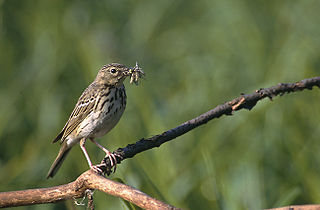
The tree pipit is a small passerine bird which breeds across most of Europe and the Palearctic as far East as the East Siberian Mountains. It is a long-distance migrant moving in winter to Africa and southern Asia. The scientific name is from Latin: anthus is the name for a small bird of grasslands, and the specific trivialis means "common".

The mosque swallow is a large swallow. It is a resident breeder in much of sub-Saharan Africa, although most common in the west. It does not migrate but follows the rains to some extent.
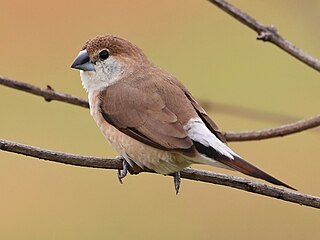
The Indian silverbill or white-throated munia is a small passerine bird found in the Indian Subcontinent and adjoining regions that was formerly considered to include the closely related African silverbill. This estrildid finch is a common resident breeding bird in the drier regions of the Middle East and the Indian Subcontinent. It has also been introduced into many other parts of the world and has become established in some areas. They forage in small flocks in grassland and scrub habitats.
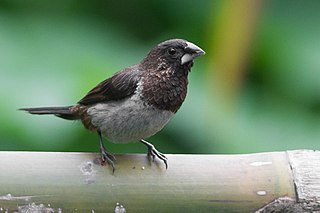
The white-rumped munia or white-rumped mannikin, sometimes called striated finch in aviculture, is a small passerine bird from the family of waxbill "finches" (Estrildidae). These are not close relatives of the true finches (Fringillidae) or true sparrows (Passeridae).

The red-cheeked cordon-bleu or red-cheeked cordonbleu is a small passerine bird in the family Estrildidae. This estrildid finch is a resident breeding bird in drier regions of tropical Sub-Saharan Africa. Red-cheeked cordon-bleu has an estimated global extent of occurrence of 7,700,000 km2.

The red-billed firefinch or Senegal firefinch is a small seed-eating bird in the family Estrildidae. This is a resident breeding bird in most of Sub-Saharan Africa with an estimated global extent of occurrence of 10,000,000 km2. It was introduced to Egypt, but the population there has become extinct. It was also introduced to southern Algeria where it is currently expanding northward.

The red avadavat, red munia or strawberry finch, is a sparrow-sized bird of the family Estrildidae. It is found in the open fields and grasslands of tropical Asia and is popular as a cage bird due to the colourful plumage of the males in their breeding season. It breeds in the Indian Subcontinent in the monsoon season. The species name of amandava and the common name of avadavat are derived from the city of Ahmedabad in Gujarat, India, from where these birds were exported into the pet trade in former times.
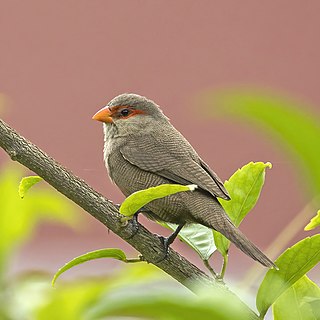
The common waxbill, also known as the St Helena waxbill, is a small passerine bird belonging to the estrildid finch family. It is native to sub-Saharan Africa but has been introduced to many other regions of the world and now has an estimated global extent of occurrence of 10,000,000 km2. It is popular and easy to keep in captivity.

The green-winged pytilia is a small colourful seed-eating bird in the family Estrildidae. It is widespread throughout Sub-Saharan Africa, though it is more rarely seen in central, far southern and coastal western parts of the continent.
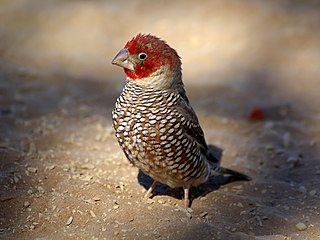
The red-headed finch is a common species of estrildid finch found in Africa. It has an estimated global extent of occurrence of 1,600,000 km2. It is found in Angola, Botswana, Lesotho, Namibia, South Africa and Zimbabwe.

The African firefinch, also called the blue-billed firefinch, is a common species of estrildid finch found in many parts of Africa. It has an estimated global extent of occurrence of 5,400,000 km2 (2,100,000 sq mi).

The violet-eared waxbill or common grenadier is a common species of estrildid finch found in drier land of Southern Africa.

The grey waxbill or black-tailed waxbill is a common species of estrildid finch found in wetter land of Southern Africa. It has an estimated global extent of occurrence of 670,000 km2.

The fawn-breasted waxbill is a common species of estrildid finch found in central Africa. It has an estimated global extent of occurrence of 1,800,000 km2. Estrilda paludicola, E. ochrogaster and E. poliopareia have been lumped into E. paludicola.

The Cape wagtail, also known as Wells's wagtail, is a small insectivorous bird which is widespread in southern Africa. It frequents water's edge, lawns and gardens. It is a mostly resident, territorial species, but has been known to undertake limited altitudinal migration or form flocks outside of the breeding season. Like other wagtails they are passerine birds of the family Motacillidae, which also includes the pipits and longclaws.
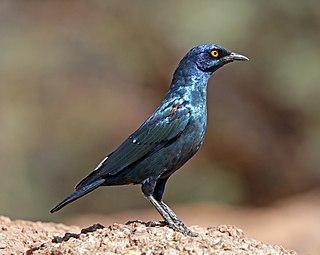
The Cape starling, also known as red-shouldered glossy-starling or Cape glossy starling, is a species of starling in the family Sturnidae. It is found in Southern Africa, where it lives in woodlands, bushveld and in suburbs.

The chestnut-bellied seed finch is a species of bird in the family Thraupidae, but was until recently placed in Emberizidae.

Uraeginthus is a genus of small seed-eating birds in the family Estrildidae that are found in Sub-Saharan Africa.

The southern red bishop or red bishop is a small passerine bird belonging to the bishop and widowbird genus Euplectes in the weaver family, the Ploceidae. It is common in wetlands and grassland in Africa south of the Equator. North of the Equator, it is replaced by the northern red bishop or orange bishop which was formerly regarded as a subspecies of this species.






















